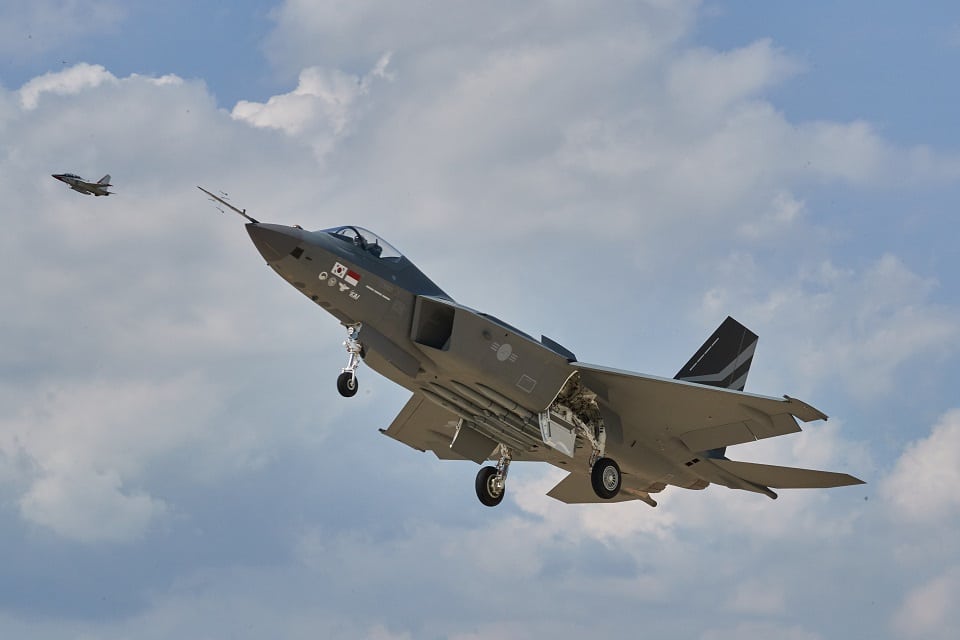Aerospace
UAE reportedly seeking a role in KF21 fighter jet

The Financial News, a South Korean daily, said on Thursday that the UAE’s Tawazun Economic Council had sent a letter to South Korea’s Office of National Security explaining Abu Dhabi’s desire in direct cooperation on the development of the KF-21.
Surprisingly, the letter allegedly requested that Abu Dhabi replace Indonesia’s investment in the program.
South Korea’s KF-21 Boramae Takes To the Air(Opens in a new browser tab)
Indonesia holds a 20% shareholding but has failed to meet its financial obligations. Jakarta, which had planned to purchase up to 50 KF-21s, joined the program in 2010 but fell behind on payments in 2017, owing an estimated $557 million by July 2022. In May, Jakarta attempted to assuage Seoul’s fears by announcing a revised payment schedule.
The KF-21 Boramae’s stealth capabilities are a crucial feature. The aircraft is equipped with modern stealth technology such as a low-observable design, radar-absorbent materials, and internal weapon carriage.
These features lower the radar cross-section of the aircraft, making it more difficult to detect and track hostile radars. The KF-21’s stealth characteristics increase its survivability and allow it to more effectively infiltrate opposing defenses.
The UAE’s alleged interest is not surprising. After all, Abu Dhabi pledged $30 billion in South Korean businesses, including defense, in January. The affluent Arab kingdom inked a $3.5 billion contract with South Korea for the Cheongung II KM-SAM air defense missile system in January 2022, the largest-ever arms export transaction for Seoul at the time.
As these multibillion-dollar investments in the South Korean industry illustrate, the UAE would have little issue repaying Indonesia’s debt to the Boramae programme. Furthermore, Abu Dhabi would surely be interested in co-producing the fighter since it would aid in the development of its domestic defence sector through significant technology transfers, which Seoul has proven to be generous with.
The UAE has halted talks with the US over a record sale for 50 fifth-generation F-35 Lightning II stealth planes in late 2021 due to differences over American preconditions and Emirati cooperation with China.
The KF-21 Boramae is powered by two General Electric F414-GE-400K afterburning turbofan engines. These engines provide the necessary thrust for the aircraft’s high-performance capabilities. The F414 engines are known for their reliability, fuel efficiency, and ability to operate in various environmental conditions. They enable the KF-21 to achieve the supersonic speeds and maneuverability required for air combat scenarios.
On the other hand, India, China, and Turkey are already in the process of developing their own Fifth Generation Fighter Jet. Turkey has already exhibited it and is awaiting the final engine selection for their 5th generation fighter plane. Americans are looking forward to the 6th generation fighter jet, which will be the most advanced in terms of engine thrust and weapons technology.
Most countries are working together to develop collaborative efforts to build their own fighter plane.

Aerospace
When Ratan Tata was denied entry to the airfield at the Aero India show, he waited

During our visit to Aero India 2019, we had the unexpected opportunity to see Ratan Tata at the event, which was a thrilling moment for us. However, there was a surprising hiccup when the security staff didn’t allow him to enter due to a lack of a security pass.
Despite this, he remained calm and patiently waited for about 20 minutes until a member of the Tata team brought him the required pass, after which he calmly proceeded inside. It was a humbling sight, showcasing his composed demeanor even in such situations.
Ratan Tata ji is not only a renowned industrialist but also a trained pilot, holding a pilot’s license. In 2007, he became the first Indian civilian to fly the F-16 Falcon during the Aero India show in Bangalore—a proud moment for the nation.
His passion for aviation extended beyond flying, as he played a key role in shaping India’s aerospace industry. Under his leadership, Tata ventured into manufacturing and maintaining aerospace components while upholding its legacy of quality. Notably, Tata’s collaboration with Airbus to develop and manufacture the C295 aircraft is a testament to its growing influence in the sector.
-

 Aviation2 months ago
Aviation2 months agoMicrosoft Flight Simulator Raises $3 Million to Bring Back the An-225 Mriya
-

 Airlines2 months ago
Airlines2 months agoQatar Citizens Can Travel to the United States Without a Visa
-

 Aviation2 months ago
Aviation2 months agoQatar Airways bans these new Electronic Devices on plane
-

 Airlines2 months ago
Airlines2 months agoJapan Airlines Rolls Out Free Domestic Flights to International Passengers
-

 Travel2 months ago
Travel2 months agoQatar Airways Launches Four Additional Flights from Amsterdam
-

 Defence2 months ago
Defence2 months agoWhich Country Has the Largest Fleet of Fighter Aircraft?
-

 Airport2 months ago
Airport2 months agoWestern Sydney Airport Welcomes Its First Plane After 6 Years of construction
-

 Airlines4 days ago
Airlines4 days agoDAMAC Air: Dubai’s New Luxury Airline Offers Free Flights for Registration








